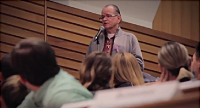While attending the Canadian premiere screening of On the Edge: Living with Epilepsy in October, James Burnett said he wanted to write a letter to Epilepsy Ontario detailing what life with a seizure disorder has been like for him and to share helpful coping mechanisms.

Burnett’s decision to share his story was well timed. On the Edge: Living with Epilepsy was written and directed by Louis Stanislaw, a U.S. filmmaker who has coped with epilepsy his whole life. The film tells the painful truths, misunderstandings and difficulties of living with epilepsy at every turn; from family life to school, to leaving home, and starting a career and forming lasting bonds.
Perhaps most importantly, the film puts faces to the condition, which is meant to inject a better sense of empathy into those listening to the many personal stories unfold.
Upon seeing the film, Burnett decided to put his face to epilepsy, which he has had for nearly 60 years. He recently made good on his commitment to share his story with its many interesting and inspiring footnotes with Epilepsy Ontario.
While in Grade 9, Burnett began having what he describes as “sensations” in his head. At first, he and his family didn’t put much stock in these “sensations” which didn’t amount to much more than an odd feeling. Later, he discovered he was having seizures without recognizing them as such.
Eventually, Burnett was diagnosed with petit mal seizures, now called absence seizures. A doctor at Toronto’s Mount Sinai Hospital discovered scar tissue on Burnett’s brain that he believed was causing the seizures. Burnett believes the scarring came from hitting his head during a fall as a youngster.
Upon being diagnosed with epilepsy as a young man, Burnett says the first thing he did was tell himself he was not “going to let epilepsy control my life.”
“(I also) knew that there were people who had more serious seizures than I did, so when I felt a sensation coming on I just prayed to God that I could accept it on behalf of someone else who may have a more severe one,” Burnett writes.
He also found a unique way of controlling seizures. Whenever he felt the “sensations” in his head, he would immediately sing Keep Right on to the End of the Road by Sir Harry Lauder. He later changed this to singing When You Walk Through a Storm.
“I believe that singing these songs helped me to keep going, not necessarily every time, but just once or twice is a blessing,” Burnett says.
“I really believe that having seizures, to some extent, is a case of mind over matter. The more occupied mentally I am the less likelihood that my brain would allow time for a seizure to interrupt my train of thought.”
True to his commitment to himself, Burnett has not let epilepsy dominate his life. He married, held jobs and sings in his church choir.
Reflecting on living with epilepsy, Burnett recalls hearing a suggestion recently that the condition needs a name change to something “more acceptable.” Pondering this notion, he offers a final thought.
“Well, sugar is sweet until you put diabetes after it,” he says. “In short, you can change the name but not the illness.”
Writer: Deron Hamel
If you have feedback on this story, or have a story of your own that you would like to share, please contact the newsroom at 800-294-0051, ext. 23, or e-mail deron(at)axiomnews.ca. You can also leave a comment below.






